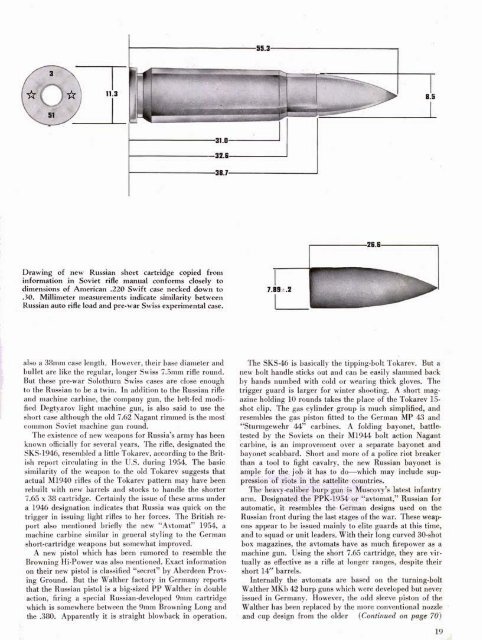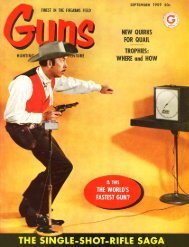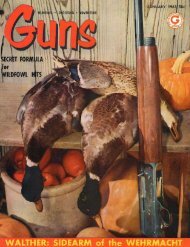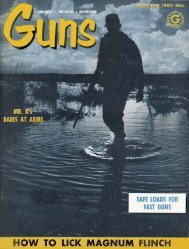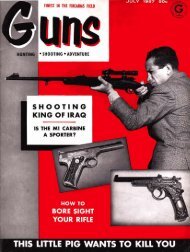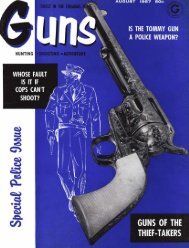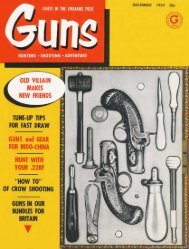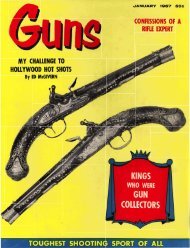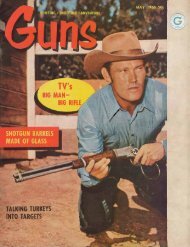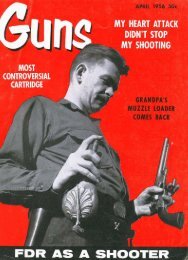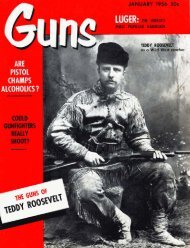You also want an ePaper? Increase the reach of your titles
YUMPU automatically turns print PDFs into web optimized ePapers that Google loves.
Drawing of new Russian short cartridge copied from<br />
information in Soviet rifle manual conforms closely to<br />
dimensions of American .220 Swift case necked down to<br />
.30. Millimeter measurements indicate similarity between<br />
Russian auto rifle load and pre-war Swiss experimental case.<br />
Â¥<br />
also a 38mm case length. However, their base diameter and<br />
bullet are like the regular, longer Swiss 7.5mm rifle round.<br />
But these pre-war Solothurn Swiss cases are close enough<br />
to the Russian to be a twin. In addition to the Russian rifle<br />
and machine carbine, the company gun, the belt-fed modi-<br />
fied Degtyarov light machine gun, is also said to use the<br />
short case although the old 7.62 Nagant rimmed is the most"<br />
common Soviet machine gun round.<br />
The existence of new weapons for Russia's army has been<br />
known officially for several years. The rifle, designated the<br />
SKS-1946, resembled a little Tokarev, according to the Brit-<br />
ish report circulating in the U.S. during 1954. The basic<br />
similarity of the weapon to the old Tokarev suggests that<br />
actual M1940 rifles of the Tokarev pattern may have been<br />
rebuilt with new barrels and stocks to handle the shorter<br />
7.65 x 38 cartridge. Certainly the issue of these arms under<br />
a 1946 designation indicates that Russia was quick on the<br />
trigger in issuing light rifles to her forces. The British re-<br />
port also mentioned briefly the new "Avtomat" 1954, a<br />
machine carbine similar in general styling to the German<br />
short-cartridge weapons but somewhat improved.<br />
A new pistol which has been rumored to resemble the<br />
Browning Hi-Power was also mentioned. Exact information<br />
on their new pistol is classified "secret" by Aberdeen Prov-<br />
ing Ground. But the Walther factory in Germany reports<br />
that the Russian pistol is a big-sized PP Walther in double<br />
action, firing a special Russian-developed 9mm cartridge<br />
which is somewhere between the 9mm Browning Long and<br />
the .380. Apparently it is straight blowback in operation.<br />
The SKS-46 is basically the tipping-bolt Tokarev. But a<br />
-- -<br />
new bolt handle sticks out and can be easily slammed back<br />
by hands numbed with cold or wearing thick gloves. The<br />
trigger guard is larger for winter shooting. A short mag-<br />
azine holding 10 rounds takes the place of the Tokarev 15-<br />
shot clip. The gas cylinder group is much simplified, and<br />
resembles the gas piston fitted to the German MP 43 and<br />
"Sturmgewehr 44" carbines. A folding bayonet, battle-<br />
tested by the Soviets on their M1944 bolt action Nagant<br />
carbine, is an improvement over a separate bayonet and<br />
bayonet scabbard. Short and more of a police riot breaker<br />
than a tool to fight cavalry, the new Russian bayonet is<br />
ample for the job it has to do-which may include sup-<br />
pression of riots in the sattelite countries.<br />
The heavy-caliber burp gun is Muscovy's latest infantry<br />
arm. Designated the PPK-1954 or "avtomat," Russian for<br />
automatic, it resembles the German designs used on the<br />
Russian front during the last stages of the war. These weap-<br />
ons appear to be issued mainly to elite guards at this time,<br />
and to squad or unit leaders. With their long curved 30-shot<br />
box magazines, the avtomats have as much firepower as a<br />
machine gun. Using the short 7.65 cartridge, they are vir-<br />
tually as effective as a rifle at longer ranges, despite their<br />
short 14" barrels.<br />
Internally the avtomats are based on the turning-bolt<br />
Walther MKb 42 burp guns which were developed but never<br />
issued in Germany. However, the odd sleeve piston of the<br />
Walther has been replaced by the more conventional nozzle<br />
- and cup design from the older (Continued on page 70)


